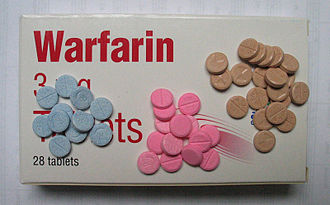Did you know that warfarin, also known as Coumadin—that stuff that Grampa takes to prevent a stroke—was originally developed as a rat poison? It came as a surprise to me.
 |
| Kale can combat the effects of Warfarin |
It becomes more potent when taken with aspirin or other NSAID drugs like Advil and it's also given a boost by garlic and ginger.
The substance now called warfarin was first discovered in the
.jpg/330px-Melilotus_indicus_(Flower).jpg) |
| Warfarin was first discovered in spoiled sweet clover |
This mysterious substance prevented vitamin K from forming blood clots, so the cattle would die from minor cuts and abrasions or develop internal bleeding.
It wasn't until 1940 that scientists at the University of Wisconsin isolated the anticoagulant that caused the bleeding and gave it a name: dicoumarol.
 |
| Coumarin makes new-mown grass smell sweet |
After World War II, researchers at the University of Wisconsin patented the substance as "Warfarin," a name derived from the acronym WARF: (Wisconsin Alumni Research Foundation) and the suffix "arin" from coumarin.
Warfarin was first registered for use as a rodenticide in the US in 1948.
 |
| Rats soon became immune to Warfarin |
In 1954, Warfarin was approved for medicinal use. But patients have to be carefully monitored to make sure the right balance of Vitamin K is preserved. It can cause skin necrosis and "purple toe syndrome" if the dose is too high. It is risky enough that pregnant women are advised not to take it.
But it stopped working as a rodenticide because rats developed immunity to it. That led scientists to produce "superwarfarins" brodifacoum, diphenadione, chlorophacinone, and bromadiolone . These superwarfarins are marketed under a number of colorfully named brands like Pestoff, Ratshot, Mouser, Havoc, and the better known D-Con.
Both warfarin and superwarfarin can kill humans. The Handbook of Pesticide Toxicology reports that a 32 year old man was murdered by being given warfarin for 13 days. Since the drugs are odorless and tasteless, they are easy to administer, but the killer has to stay around for at least a couple of weeks.
In 1988, two teenaged girls tried to murder their parents using the superwarfarin D-Con. But luckily the parents went for medical help for the symptoms before they succumbed to the poison.
| It's not a good idea to add warfarin to your weed. |
One young Einstein in Utah decided that if smoking rat poison was good, eating it would be even better. He nearly died of the bleeding disorder before he admitted he had been munching on D-Con.
 |
| You'd need a lot of these to do in nasty old Aunt Augusta |
To the mystery writer, warfarin and its nastier cousins might provide some interesting plots. If the wealthy, bullying matriarch everybody is hoping will die is already taking warfarin for a medical condition, a little of the colorless, tasteless rat poison in her cocoa might make for the perfect murder. Hmmm.
What about you? Have you read a mystery where warfarin is used as a weapon? Can you think of a good plot for murder by warfarin?
Here's a list of all the posts in the poison series
Part 25: Yew
Part 26: Toxic Relationships
THE LADY OF THE LAKEWOOD DINER is a comedy that pokes fun at the myth of a Golden Age, making parallels between the Grail legend and the self-mythologizing of the Baby Boomer Generation.
Someone has shot aging bad-girl rocker Morgan Le Fay and threatens to finish the job. Is it fans of her legendary dead rock-god husband, Merlin? Or is the secret buried in her childhood hometown of Avalon, Maine?
Morgan's childhood best friend Dodie, the no-nonsense owner of a dilapidated diner, may be the only one who knows the dark secret that can save Morgan's life. And both women may find that love really is better the second time around. Think Beaches meets Fried Green Tomatoes at the Whistle Stop Cafe.
Part 26: Toxic Relationships
Enjoy the post? Take a look at some of my books!
THE LADY OF THE LAKEWOOD DINER is a comedy that pokes fun at the myth of a Golden Age, making parallels between the Grail legend and the self-mythologizing of the Baby Boomer Generation.
Someone has shot aging bad-girl rocker Morgan Le Fay and threatens to finish the job. Is it fans of her legendary dead rock-god husband, Merlin? Or is the secret buried in her childhood hometown of Avalon, Maine?
Morgan's childhood best friend Dodie, the no-nonsense owner of a dilapidated diner, may be the only one who knows the dark secret that can save Morgan's life. And both women may find that love really is better the second time around. Think Beaches meets Fried Green Tomatoes at the Whistle Stop Cafe.
The Lady of the Lakewood Diner is only $2.99 at all the Amazons, iTunes, Kobo, Nook and Books 2 Read
